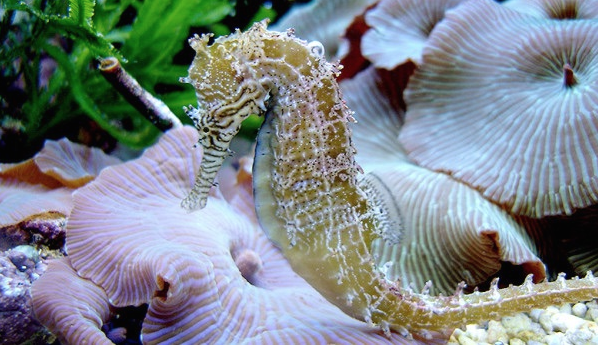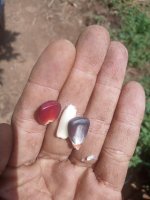Cuddles
Well-known member
Some pleasant news for a change. To be perfectly honest, I had no idea that they ever lived in the north sea at all! So this is really wonderful imo: 
Seas: are seahorses returning to the North Sea?

Experts worldwide have already described more than 40 species of seahorses living in tropical and temperate seas. Their biodiversity is particularly high in southern Australia and off New Zealand. Typically, the small fish live in relatively sheltered areas such as coral reefs, mangroves or seagrass meadows.
In addition to their bizarre appearance, the animals are also known for their unusual lifestyle. Because with them the males become pregnant. During mating, the females inject their eggs into their breast pockets, where the offspring then develop for two to three weeks. After that, the young animals spread out in the seagrass forest – and their parents can set to work creating a new generation.
However, this type of couple relationship and family life carries risks. Because seahorses never live together in dense populations. So when they lose their partner, it is sometimes difficult for them to find a replacement. And even if that works, the team is not yet very well attuned and therefore may not be as successful in rearing the young.
Even under perfect conditions, however, the animals reproduce relatively slowly and are correspondingly sensitive to overfishing. In addition, they need complex habitats that are becoming increasingly rare in many marine regions. The International Union for Conservation of Nature (IUCN) therefore classifies many species as endangered or critically endangered. Since 2004, all seahorses have come under CITES, restricting international trade.
A seagrass meadow seems to fulfill all these conditions perfectly from a seahorse’s point of view. Both species occur in numerous other habitats throughout Europe. But that’s where they obviously have their strongholds. “It could well be that the animals used to live in the seagrass meadows of the Wadden Sea,” says Hans-Ulrich Rösner. Larger populations of these plants now only grow in tidal flats that dry out at low tide and are therefore unsuitable for seahorses. But that was not always so. “At the beginning of the 20th century there were seagrass meadows in the Wadden Sea that were constantly under water,” says the WWF expert. In the 1930s, these stocks were overwhelmed by the pathogen Labyrinthula zosterae destroyed. And they still haven’t recovered from that.
Did the disappearance of these habitats seal the temporary end of the seahorses in the Wadden Sea? “So far, that’s just a theory,” emphasizes the biologist. “We just don’t know.” Experts aren’t even sure whether the animals used to live off the German coast at all. While there are rumors about it, hard evidence is lacking. Experts have been researching the Wadden Sea around Sylt for more than 100 years. But the two hippocampus-Species do not appear in the old species lists. It is therefore unclear whether the current seahorse boom is actually a return of extinct tideland dwellers. “It could also be that the animals are now settling here for the first time due to the warmer water temperatures as a result of climate change,” explains Rösner
.
Similar speculation arose years ago about seahorses in Britain. Then Neil Garrick-Maidment and his colleagues from the seahorse protection organization Seahorse Trust went in search of clues. Not only did they come across observational notes dating back to 1821. But also a few telltale art objects from olden times.
The Staffordshire Treasure, for example, contains thousands of Anglo-Saxon gold and silver objects from the 6th and 7th centuries. Underneath is an artistically designed brooch in the shape of a seahorse. Pictish stone pillars from the 3rd and 4th centuries also depict fish with the characteristic prehensile tail. Neil Garrick-Maidment is convinced that the artists of that time must have had living or recently deceased specimens as models. Otherwise they would hardly have been able to depict the bizarre water creatures so lifelike with all the small fins and other details. For him it is clear that the animals have been around in Great Britain for a very long time. The short- and long-snouted seahorses are now officially recognized as part of the native fauna.
Recently, the sightings of the old horse-headed neighbors in the UK have also increased. In 1994 the Seahorse Trust began reviewing old reports and collecting new observations. This has meanwhile become the largest and most ancient seahorse database in the world. And the figures of this “British Seahorse Survey” speak a clear language. Between 1821 and 1990, an average of between one and four seahorses were spotted off Britain’s coasts. Between 1990 and 2019, on the other hand, it was 48 to 49 per year. According to Neil Garrick-Maidment, however, this is mainly due to the fact that more people are now interested in the bizarre little animals and keep their eyes open for them. So far, he has not seen any solid evidence of a connection with climate change.
However, global warming is still being discussed as a possible cause for the current developments in the Wadden Sea. Because as species that prefer warmth, the seahorses could benefit from rising water temperatures there. And there is one more change that could benefit them. Maybe they’re using Japanese kelp instead of seaweed Sargassum muticum as habitat. This invasive brown alga, originally from Asia, has spread to almost all European coasts with oyster transports and by sticking to the hulls of ships. Also in the North Sea. It is very popular with seahorses because it provides ample shelter and clinging opportunities.
Seas: are seahorses returning to the North Sea?

Eccentrics at Risk: Seahorses
Experts worldwide have already described more than 40 species of seahorses living in tropical and temperate seas. Their biodiversity is particularly high in southern Australia and off New Zealand. Typically, the small fish live in relatively sheltered areas such as coral reefs, mangroves or seagrass meadows.
In addition to their bizarre appearance, the animals are also known for their unusual lifestyle. Because with them the males become pregnant. During mating, the females inject their eggs into their breast pockets, where the offspring then develop for two to three weeks. After that, the young animals spread out in the seagrass forest – and their parents can set to work creating a new generation.
However, this type of couple relationship and family life carries risks. Because seahorses never live together in dense populations. So when they lose their partner, it is sometimes difficult for them to find a replacement. And even if that works, the team is not yet very well attuned and therefore may not be as successful in rearing the young.
Even under perfect conditions, however, the animals reproduce relatively slowly and are correspondingly sensitive to overfishing. In addition, they need complex habitats that are becoming increasingly rare in many marine regions. The International Union for Conservation of Nature (IUCN) therefore classifies many species as endangered or critically endangered. Since 2004, all seahorses have come under CITES, restricting international trade.
A seagrass meadow seems to fulfill all these conditions perfectly from a seahorse’s point of view. Both species occur in numerous other habitats throughout Europe. But that’s where they obviously have their strongholds. “It could well be that the animals used to live in the seagrass meadows of the Wadden Sea,” says Hans-Ulrich Rösner. Larger populations of these plants now only grow in tidal flats that dry out at low tide and are therefore unsuitable for seahorses. But that was not always so. “At the beginning of the 20th century there were seagrass meadows in the Wadden Sea that were constantly under water,” says the WWF expert. In the 1930s, these stocks were overwhelmed by the pathogen Labyrinthula zosterae destroyed. And they still haven’t recovered from that.
Did the disappearance of these habitats seal the temporary end of the seahorses in the Wadden Sea? “So far, that’s just a theory,” emphasizes the biologist. “We just don’t know.” Experts aren’t even sure whether the animals used to live off the German coast at all. While there are rumors about it, hard evidence is lacking. Experts have been researching the Wadden Sea around Sylt for more than 100 years. But the two hippocampus-Species do not appear in the old species lists. It is therefore unclear whether the current seahorse boom is actually a return of extinct tideland dwellers. “It could also be that the animals are now settling here for the first time due to the warmer water temperatures as a result of climate change,” explains Rösner
.
An old story
Similar speculation arose years ago about seahorses in Britain. Then Neil Garrick-Maidment and his colleagues from the seahorse protection organization Seahorse Trust went in search of clues. Not only did they come across observational notes dating back to 1821. But also a few telltale art objects from olden times.
The Staffordshire Treasure, for example, contains thousands of Anglo-Saxon gold and silver objects from the 6th and 7th centuries. Underneath is an artistically designed brooch in the shape of a seahorse. Pictish stone pillars from the 3rd and 4th centuries also depict fish with the characteristic prehensile tail. Neil Garrick-Maidment is convinced that the artists of that time must have had living or recently deceased specimens as models. Otherwise they would hardly have been able to depict the bizarre water creatures so lifelike with all the small fins and other details. For him it is clear that the animals have been around in Great Britain for a very long time. The short- and long-snouted seahorses are now officially recognized as part of the native fauna.
Recently, the sightings of the old horse-headed neighbors in the UK have also increased. In 1994 the Seahorse Trust began reviewing old reports and collecting new observations. This has meanwhile become the largest and most ancient seahorse database in the world. And the figures of this “British Seahorse Survey” speak a clear language. Between 1821 and 1990, an average of between one and four seahorses were spotted off Britain’s coasts. Between 1990 and 2019, on the other hand, it was 48 to 49 per year. According to Neil Garrick-Maidment, however, this is mainly due to the fact that more people are now interested in the bizarre little animals and keep their eyes open for them. So far, he has not seen any solid evidence of a connection with climate change.
A mysterious journey
However, global warming is still being discussed as a possible cause for the current developments in the Wadden Sea. Because as species that prefer warmth, the seahorses could benefit from rising water temperatures there. And there is one more change that could benefit them. Maybe they’re using Japanese kelp instead of seaweed Sargassum muticum as habitat. This invasive brown alga, originally from Asia, has spread to almost all European coasts with oyster transports and by sticking to the hulls of ships. Also in the North Sea. It is very popular with seahorses because it provides ample shelter and clinging opportunities.




